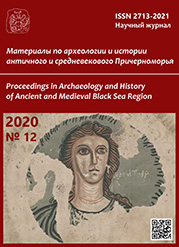Бусы и элементы декора из янтаря в ювелирных изделиях из погребений кочевников Азиатской Сарматии в контексте торговли экзотическими материалами в Евразии
Beads and decoration elements made of amber in items of jewelry from the burials of the nomads of Asian Sarmatia in the context of trade in exotic materials in Eurasia
Author(s): Mikhail Ju. TreisterSubject(s): Archaeology
Published by: Нижневартовский государственный университет
Keywords: amber; “Amber Road”; beads, elements of jewelry decoration; Celts; Scythians; Sarmatians; Xiongnu; nomads; Mediterranean; Black Sea area; Central Asia; China; Siberia; Mongolia; Eurasia;
Summary/Abstract: If the distribution of amber in Europe has been studied quite fully, then the study of the distribution of amber in Eurasia is replete with white spots. This also applies to amber jewelry among the nomads. The focus of the present article is amber jewelry among the nomads of Asian Sarmatia in the context of its distribution in Eurasia in the Early Iron Age. In this regard, the distribution of amber beads in Central Europe, Italy, the Balkans, and Scythia in the 7th — 4th centuries BCE, in the necropoleis of the ancient cities of the North Pontic region of the 6th — 4th centuries BCE, Colchis — of the 5th — 4th centuries BCE, in the Near East, Central Asia, in Siberia and Mongolia is considered.No later than the 4th century BCE items made of amber, mainly originating from the territory of Ukraine and the Baltics, rare in this period in the North Pontic area and unknown in Scythia, appear in the Sarmatian burials of the Southern Urals, where they are found more often and in larger numbers in the complexes of the 3rd and 3rd — 2nd centuries BCE. Two possible ways of distribution are considered. One — across the Northern and Eastern Black Sea regions, further on via Caucasus, Caspian Sea and the old bed of Uzboy, which seems preferable, and the second — via Western Asia, which hardly correlates with the provenance of the material of the majority of beads from Prokhorovka in the Urals.In the burial complexes of Asian Sarmatia of the 2nd — 1st centuries BCE amber beads are extremely rare and are presented in single quantities both in the Trans-Volga region and in the Lower Don. It is not excluded that such beads found their way via both Western Asia and Central Europe (through Tanais). No later than the 1st century BCE amber beads are beginning to be used both in Hindustan and Central Asia, as well as in Eastern Siberia and China. Attention is drawn to their rather wide distribution in the burials of the Xiongnu in Mongolia in the late 1st century BCE — 1st century CE. In this region and probably in Bactria, judging by the finds from the Tillya-tepe, amber was also used as a material of inlays in jewelry and belt buckles. Despite the fact that it is obvious that amber beads could have come to the Xiongnu and China from the west (as Baltic amber was used to make beads from the early Scythian Burial-mound Arzhan-2 in Tuva), the fact that it may not have necessarily been of Baltic origin, but originate from Burma, was confirmed by the study of amber objects from the 1st century CE tomb M18 in Nanyang.In the 1st — first half of the 2nd century CE amber beads are widespread both in the necropoleis of ancient cities and settlements of the North Pontic region, as well as in the barbarian burials of the Crimea, Sarmatian burials in the Bug and Dnieper regions. There are relatively few of them in the burials of the nomads of the Lower Don region — they are more often found in the interfluve of the Volga and Don. Amber beads are especially common in burials of the Late Sarmatian period, when they are known practically throughout the territory of Sarmatia from the Carpathian-Danube basin to the steppes of the Southern Urals. In Asian Sarmatia, three clusters are distinguished: first of all — the Lower Don region and the southern part of the Volga-Don interfluve, as well as — the South Urals and the interfluve of the Khoper and Volga. During this period amber was widely used for the manufacture of pommels of swords and daggers.Starting from the 2nd — 1st centuries BCE amber beads in burials are quite often found together with coral beads and pendants (in 40—47% of cases). This may indicate a common source of beads made from these exotic materials. In the 4th — 3rd centuries BCE, when jewelry made of amber and coral appeared among the Sarmatians of the Southern Urals, it is likely that the ways of their distribution were different. Corals were more likely to arrive through Western Asia.
Journal: Материалы по археологии и истории античного и средневекового Причерноморья
- Issue Year: 2020
- Issue No: 12
- Page Range: 148-223
- Page Count: 76
- Language: Russian

